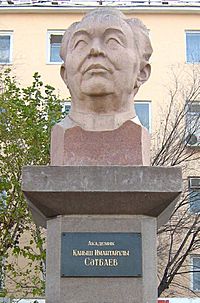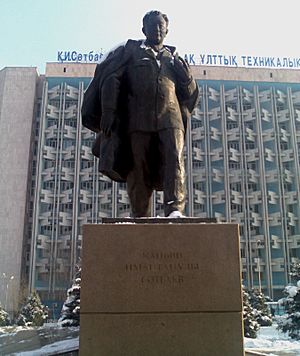Kanysh Satbayev facts for kids
Quick facts for kids
Kanysh Satbayev
|
|
|---|---|

Kanysh Satbayev
|
|
| Born | 12 April 1899 Semipalatinsk Oblast, Kazakhstan
|
| Died | 31 January 1964 (aged 64) |
| Nationality | Kazakhs |
| Citizenship | USSR |
| Alma mater | Tomsk Polytechnic University |
| Known for | First president of the Kazakhstan Academy of Sciences |
| Scientific career | |
| Fields | Geology |
Kanysh Satbayev (born April 11, 1899 – died January 31, 1964) was a famous Kazakh scientist. He was a professor and a geologist. He helped create the field of metallogeny in the Soviet Union, especially in Kazakhstan.
Satbayev was also the main supporter and first president of the Kazakhstan Academy of Sciences. He earned a doctorate in Geological and Mineralogical Sciences in 1942. He became a professor in 1950. He was also a member of the Academy of Sciences of the Soviet Union. He is well-known for finding the huge Ulutau-Dzhezkazgan copper deposit. At the time, this was one of the largest known copper reserves.
Contents
Kanysh Satbayev's Early Life and Education
Kanysh Satbayev was born in 1899 in what is now the Bayanaul District of the Pavlodar Region in Kazakhstan. When he was a child, a geologist named Mikhail Usov sparked his interest in geology. Kanysh was the youngest of three children.
From 1909 to 1911, he went to a local school. In 1911, he joined a Russian-Kazakh school in Pavlodar. He finished with honors in 1914. After that, he went to a teachers' seminary in Semipalatinsk.
During his studies, he faced health problems due to tuberculosis. Despite this, he earned his diploma in 1918. Kanysh wanted to go to university. He spent a year and a half preparing for the Tomsk Technological Institute. He also taught natural science courses in Semipalatinsk.
His health issues got worse, and he had to stop studying for a while. Doctors thought he might not be able to continue his education. They believed he would only be able to live in his home village.
Returning to Studies and Discoveries
In 1920, Satbayev became the first chairman of a cultural and educational department in Bayanaul. He was also appointed as a local judge. In early 1921, he met geologist M.A. Usov again. Usov encouraged him to study geology.
That same year, Kanysh left his job as a judge. He was accepted into the Tomsk Technological Institute. In 1922, his tuberculosis returned, and he had to leave school again. He went back to his village to recover.
While recovering, he wrote an algebra textbook for Kazakh schools. This book, finished in 1924, was the first algebra textbook in the Kazakh language. After about a year and a half, his health improved. He returned to the Institute and graduated successfully in 1926. Kanysh Satbayev became the first qualified Kazakh mining engineer and geologist.
He passed away in Moscow in 1964. He is buried in Almaty.
Family Life
Kanysh Satbayev's father, Imantui Satpayev, was a village leader. Kanysh was one of three children. In 1920, Kanysh married Sharip, and they had two daughters. Later, he married Taisiya Alekseevna Satpayeva, and they had two more daughters.
One of his daughters, Hannisa Kanyshevna Satpayeva, became a medical doctor. She graduated with honors from the Kazakh State Medical Institute in 1943. She went on to become a professor and a Doctor of Medical Sciences. She led a department at the institute for many years.
Kanysh Satbayev's Career and Discoveries
After graduating in 1926, Kanysh Satbayev started working at a company that dealt with non-ferrous metals. He became the head of the geological department. A year later, in 1927, he joined the company's board.
The company managed a copper mine and a smelter in Karsakpai. British companies had started building the smelter years before. They left when the revolution began. Soviet authorities decided to finish the project.
Exploring Dzhezkazgan Copper
As the chief geologist, Satbayev went to explore the area. Other experts thought the copper reserves would only last 10-15 years. But Kanysh Satbayev disagreed. He believed there were huge amounts of copper in the Dzhezkazgan area.
He started exploring the region, even with limited equipment. Many experts thought his idea would fail. However, a year later, Satbayev found a large layer of ore more than ten meters thick. Tests showed it was rich in copper.
This discovery allowed him to expand his exploration work. By 1929, he had found several more large deposits. He wrote an article saying that Dzhezkazgan could become one of the richest copper regions in the world. He also suggested building a dam and a railway in the area.
His ideas were not popular with some leaders at first. They wanted to keep exploration levels low. But Satbayev insisted he was right. He presented his ideas to higher authorities. Eventually, he convinced them. More money, equipment, and people were sent to Dzhezkazgan.
It turned out that the Dzhezkazgan copper deposit was the largest in the world at that time. By 1940, a dam and a railway connecting Dzhezkazgan, Balkhash, and Karagandy were built. For his great work in discovering the wealth of the Ulutau area, Kanysh Satbayev received the Order of Lenin in 1940.
First President of the Academy of Sciences of the Kazakh SSR
Kanysh Satbayev dreamed of creating an Academy of Sciences in Kazakhstan. He started working on this idea in 1944. He traveled to Moscow often to explain why Kazakhstan needed its own Academy. He argued that it would help organize science in the region.
Between 1944 and 1946, 11 new research institutes were created. The main building for the future Academy was also designed. On June 1, 1946, the Kazakh SSR Academy of Sciences officially opened.
Two days later, on June 3, Kanysh Satbayev was elected its first president. He also became a member of the Academy of Sciences of the Soviet Union that same year. He continued to serve on important committees until his death.
Continued Scientific Work
After his time as president of the Kazakh SSR Academy of Sciences, Kanysh Satbayev continued his scientific work. He chose to stay in Almaty as the Director of the Institute of Geological Sciences.
In 1952, Satbayev gathered a team of geologists. They worked on creating special maps called "metallogenic prediction maps." These maps helped predict where minerals might be found in Central Kazakhstan. Their method was new and became very important for geological studies in the Soviet Union.
By 1953, they had created working models of these maps. Over the next four years, the maps were tested and proven to be very accurate. In December 1958, Kanysh Satbayev and his team were awarded the prestigious Lenin Prize for their work.
Kanysh Satbayev's Legacy
Kanysh Satbayev wrote over 640 scientific papers. He created the Institute of Geology, which became a key center for studying Kazakhstan's mineral resources. Many things are named in his honor:
- The city of Satpayev in the Karaganda Region.
- The Kanysh Satbayev Canal, also known as the Irtysh–Karaganda Canal.
- The mineral Satpayevite.
- The Kazakh National Technical University.
- Many streets and schools across Kazakhstan.
- The Asteroid 2402 Satpayev in the main asteroid belt.
- A mountain peak, previously called Soviets Peak.
- The Satpayev glacier.
- The Institute of Geological Sciences of the Academy of Sciences of Kazakhstan.
- The Ekibastuz Engineering and Technical Institute.
- Satbayev University.
- The Satbayev Memorial Museum.
- The Mining ring structure - Big ring Satpayev.
Today, there are many monuments dedicated to Kanysh Satbayev.
Recognition and Awards
Kanysh Satbayev received many important awards for his contributions:
- 1940, 1945, 1957, 1963 - Four Order of Lenin awards.
- 1942 - Order of the Patriotic War, 2nd degree.
- 1945 - Medal "For Valiant Labor in the Great Patriotic War of 1941-1945."
- 1942 - Stalin Prize.
- 1958 - Lenin Prize.
- 1951 - Honorary member of the Tajik Academy of Sciences.
- 1964 - The first honorary citizen of the city of Zhezkazgan.
- 1977 - The first Honorary Citizen of Satpayev.



